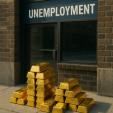Cole's Market Insights - July 6, 1997
Evidence of Slower Growth, FOMC Stands Pat
Evidence that the economy has slowed from its blistering first-quarter growth pace continues to mount. Payroll employment climbed a modest 217,000 during June, the unemployment rate rose from 4.8% to 5%, and wage gains were minuscule. Consumer spending rose a moderate 0.3% in May, about half the first quarter pace. The closely followed National Association of Purchasing Managers' Index of manufacturing activity eased a bit from 57.1 to 55.7 last month. May factory orders fell 0.7%.
To the surprise of virtually no one, the Federal Open market Committee again stood pat again last week adding further fuel to the blazing inferno on Wall Street.
Stocks Soar Again, Gold Spikes Lower
Emboldened by the FOMC and a stronger bond market, Wall Street's thundering heard of bulls trampled all before them again last week. The Dow industrials soared another 2.7% to nearly 7900; the S & P 500 jumped 3.3%. But the Russell 2000 small cap index climbed less than 1%.
August gold plunged $11.70 to $324.20 -- a new 12-year low. Prices skidded Friday after the Australian Reserve Bank revealed it had sold 167 tons of gold -- two thirds of its reserves -- in recent months. The fact a nation like Australia with a large gold mining industry did not feel any need to support the gold price made the already super-bearish consensus even more negative.
August Reversals Still Expected for Stocks and Gold
The current bull market in stocks seem unstoppable as does the ferocious bear market in gold. But history teaches that when sentiment and markets reach the truly gross extremes extant today, major reversals often are very close.
Stocks probably will roll ahead a few more weeks, with a good chance of a sharp catch-up rally by the small caps which still are lagging far behind the big boys. But a major reversal is likely in August. That will mark 4.5 months from the beginning of this latest bull phase in early April. The previous bull phase lasted twice as long (9 months). And the first bull phase ran twice as long as the second (18 months).
|
But a major reversal |
|
|
The precise nature and magnitude of this looming decline still is uncertain. Bear markets -- defined as drops of 20% or more in the Dow Industrials that last at least six months -- have always been associated with recessions. And most economists do not see a recession on the horizon (then again they almost never do). But the stock market can plunge over a short period if valuations become too stretched and investors lose confidence for one reason or another. This can occur without a recession.
|
And most economists do |
|
|
That is what happened in-mid 1962 when the market plunged 25% within a few months as the economy continued to move ahead. And it happened again in 1987 when the Dow Industrials nose dived 20% in a single day. With stocks now more richly valued than in 1929, 1962, or 1987, a steep drop could occur at breakneck speed even if the economy remains strong, inflation continues low, and the FOMC doesn't hike rates.
With gold bullion haven just broken to new 12-year lows, panic is taking over among gold investors. Many erstwhile bulls are throwing in the towel on the world's most hated asset. Central banks are selling., and to many they are all-knowing and omnipotent. Hedge funds now have a record short position that continues to expand almost daily. High-cost gold mines are starting to close. Everybody "knows" the price will soon fall to $300 and then to $250 or lower. Well known UBS gold analyst Andy Smith tells us again and again that there is "no hope" for the yellow metal. Merrill Lynch analyst Ted Arnold carries the same message.
|
Why has the U.S. -- the |
|
|
With virtually no gold bulls left in the financial community, one wonders why the noble metal hasn't already dropped to $200 or less. Could it possibly be that the permabears are overlooking a few things. Such as the fact that demand remains strong in Asia and Asian CBs do not consider the yellow metal a barbarous relic as do their western counterparts. Japanese Prime Minister Hashimoto's recent threat to sell treasuries and buy gold confirms the noble metal is far from dead as a monetary asset, despite Ted Arnold and Andy Smith. Why has the U.S. -- the fountainhead of anti gold sentiment -- not sold any of its own gold while encouraging its allies to sell?
|
Current overwhelmingly negative gold sentiment is typical of markets as they approach or hit SECULAR BOTTOMS. In fact, sentiment towards equities in 1975 was almost as negative as sentiment about gold today. Demand for gold will rise dramatically once Wall Street's record setting party comes to an end . When investor conversation starts to focus on how low stocks may sink instead of how high they might climb, talk about a gold permabear will become as extinct as the dinosaurs and as out of fashion as last year's best selling toys. |

















